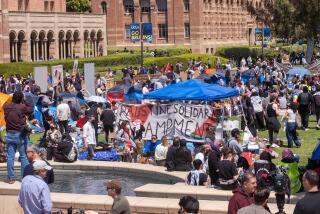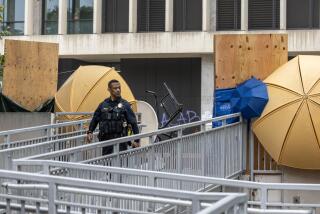CSUSM Students Get First Taste of a Real Campus
- Share via
About 1,700 Cal State San Marcos students stepped onto their new, permanent campus for the first time Monday, feeling that, after two years in a bland temporary building next to a furniture store, they were finally entering a genuine university.
“It looks like a real college now,” said Catherine Ziegler, a graduate student studying for a teaching credential. “Before, it was hard to believe it was a real university.”
Two academic buildings and a student commons were opened to students for the first day of classes, a small miracle given the construction problems the university encountered a year and a half ago and that led to predictions of a long delay in opening.
Even Cal State San Marcos President Bill Stacy, a steadfast optimist, had said back then that he would be “pleasantly surprised” if the campus opened on time. But it did, and, on Monday, Stacy beamed as he walked through the plaza of the new campus.
“I am always expecting miracles and for good things to happen every day,” Stacy said. “I had said to students and people in the area that we would be there. Little did I know how hard the boast would be to keep.”
Indeed, Craven Hall still remains under construction, and university officials said it will be mid-November before the completion of the hall that will initially house the school library as well as all administrative functions.
Until then, students will have to trek down to the old temporary campus, an industrial park 2 miles away, to find services such as financial aid, career planning and placement, counseling, the bookstore and enrollment.
But that seemed a trifling consideration as students enjoyed their new campus Monday.
“It’s nice to be in a real school,” said Joe Archer, a 28-year-old business management major who will graduate this year.
Real school or not, the first day of school was not without its glitches.
Although the university has had the last two months to furnish the two academic buildings, which include lecture rooms and science labs, the staff only just began moving into the student commons last week because a missing air-conditioning duct prevented the building from passing inspection, university officials said.
The Students Services staff put in overtime all weekend to move into new offices in the student commons. Dean Ernest Zomalt, who moved into his cubicle in the student commons on Sunday but will have to relocate to Craven Hall when it opens later this year, said he isn’t even going to unpack everything.
“I’ve got a box of mostly pictures and plaques here that will stay there,” Zomalt said. “They’re not going up on the walls because, No. 1, well, I don’t have any walls.”
Meanwhile, the students, parked in a lot that didn’t exist two weeks ago, were first greeted by a work crew installing hand rails along the stairway leading to the campus.
The dirt lawns promising drought-resistant foliage were fed by occasionally errant water sprinklers as the students marched up the cement walkway leading to their new campus.
Inside, most door signs proudly pronounced their room’s purpose in both English and Braille, while some doors had to make do with paper signs taped on that said “Women” and “Custodian.”
Still, students spoke highly of their new campus, proud to no longer be attending “Jerome’s West,” the nickname given to the old university campus that referred to its location next to a furniture store.
“It’s exciting that it’s finally open,” said 21-year-old Tristie Graetz, an English student, who expressed disappointment in the campus’ fledgling landscaping. “It’s nice to finally have a campus . . . but it’s not UCSD.”
Students felt the new campus gave their school a measure of respect that their previous location lacked.
Classrooms featured virgin blackboards and erasers, and some offered a spectacular view of tractors and bulldozers grazing away at a nearby hillside, part of the university’s seemingly continuous construction plan.
“You can’t hear it inside the classrooms,” testified Chris Fuller, a 25-year-old business management student.
The university is fortunate to have furniture to put into the new buildings, said Albert Amado, assistant vice president for construction.
Most of the tables, chairs and lecterns come from the old campus because funding for more furniture has been held up during the state budget wranglings.
The budget stalemate is also holding up the purchase of basic laboratory equipment such as microscopes, centrifuges and glassware, said biology professor Larry Cohen.
“Those labs aren’t functional until we have the equipment,” said Cohen, adding that, even if the budget were passed this week, it would be months before the labs are properly equipped.
University officials said the completion of Craven Hall later this year will conclude the $60-million first phase of the campus and will be followed by a $100-million phase that will include two more lecture halls, another laboratory building, physical education facilities and a library.
Construction of the second phase will probably begin the middle of next year and take about five years. The university’s long-term plan calls for a campus of 51 buildings, with completion slated for 2015. The student population is expected to reach about 30,000.
But, even with the first phase newly completed, university assistant vice president Albert Amado is already concerned about crowding.
“We won’t have abundant space for very long,” said Amado, who predicts that the campus will reach its capacity by the beginning of next year, and that they will encounter parking problems as early as this year.
More to Read
Sign up for Essential California
The most important California stories and recommendations in your inbox every morning.
You may occasionally receive promotional content from the Los Angeles Times.










